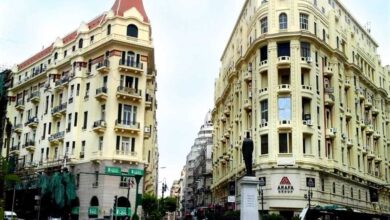I was recently sipping a cup of tea in Café Riche, Downtown Cairo’s 100-year-old café. I sat next to one of its windows, fenced with interlocking iron wires to close it off from the hurling sounds of the busy heart of town. As I was gazing at the adjacent clothing shop, words that I once read in the archives of the café came to mind.
At the turn of the twentieth century, the café’s premises extended to Talaat Harb Square with a garden in the middle that housed live performances by Aziz Eid, Umm Kalthoum and others. The performances eventually stopped as the owner had no license to run them and the British commanders, based in the area, were complaining about the noise.
As my senses were occupied imagining the garden, the performance and the angry Brits, I was interrupted by a phone message: “Come quickly. The real estate tax collectors are giving us a blast on Hussein Hegazi Street.” I gathered my scattered belongings, abandoned my daydreams, and set off to the twenty-first century streets of Downtown Cairo which I best know as they are today. I wanted to catch up with the witty chants of the tax collectors as they protested their low wages.
I belong to the offspring of a generation that constantly laments the degeneration of contemporary Cairo. I saw black and white pictures of the past featuring empty Cairene streets, stylishly dressed women in hats and elegant looking men. I had trouble identifying with those pictures, as the Cairo in which I now live is a very different place.
History has it that back in 1863, during Khedive Ismail’s rule, Cairo was a “city of bugs” which did not deserve to be visited; hearing about it was enough. The Khedive was unhappy with the label and wanted to transform Cairo into a “Paris of the East.” He strived to model it after Baron Haussman’s modernist urban and architectural development of the European city.
It took the city five years to begin resembling Khedive Ismail’s longed for colonial model. In 1872, he inaugurated Mohamed Ali Street, which extends between the Citadel and Bab el-Hadid Square (Ramses). An opera house was later established and different parts of the city were integrated with the construction of bridges like Qasr el-Nil Bridge and Abul Ela Bridge. Areas formerly occupied by ponds and agricultural lands became thriving squares such as the Abdeen Square, the Azbakiya Garden, el-Ataba el-Khadra Square, the Opera Square, Soliman Pasha Square (Talaat Harb), Khedive Tawfiq Square (Tawfiqeya) and Ismailiya Square (Tahrir), among others.
The entrances to the modern city, which were used as garbage dumps, were also restored. To its north, Bab el-Hadid was established as the city’s northern gate and railway transit point. To its east, palaces and gardens replaced the small radish farms known as fagalla (fegl being the Arabic word for radish). The Khedive also paved a straight road to the western gate of the city where the Giza pyramids stand. And finally, the area around the southern gate, in Helwan and Maadi, was cleaned up and urbanized.
Roads with pedestrian compartments were paved. Gaslights were set. Gardens were planted with Indian, Sudanese and African plants. Palaces were established by the notables of Cairo who were summoned by the Khedive to take plots of land in the modernized city and build outstanding houses to embody its new urban identity.
Nowadays, the glamor of the city center as imagined by Khedive Ismail has been defeated by constant reinvention. Its claimed nineteenth-century modernity is overpowered by newer modernities, as manifested by satellite cities and suburban developments. But nostalgia cannot be the sole sentiment that colors memories of Downtown Cairo. The city center is a site of something else, something more contemporary.
Those of us who manage to escape this nostalgic trap find a contemporary glamor in Downtown Cairo’s run-down baladi cafés, its few independent art production spaces, and its fiery protests at times of national anguish.
Amid the revulsion of some of our elders and the nostalgic rants of some others, we constantly seek to renegotiate our relationship with the city by “doing” Downtown. The nostalgic accounts are historical references. The present is the untapped moment that nostalgia overshadows. We travel between the two while embarking on an exercise of interrogating our own visions and aspirations for the city.
“We won’t leave. We won’t leave,” chanted the real estate tax collectors from the pavement of Hussein Hegazi Street. Their vehement chants are a newborn beat to the heart of town.
We grab this moment and dwell on it.




